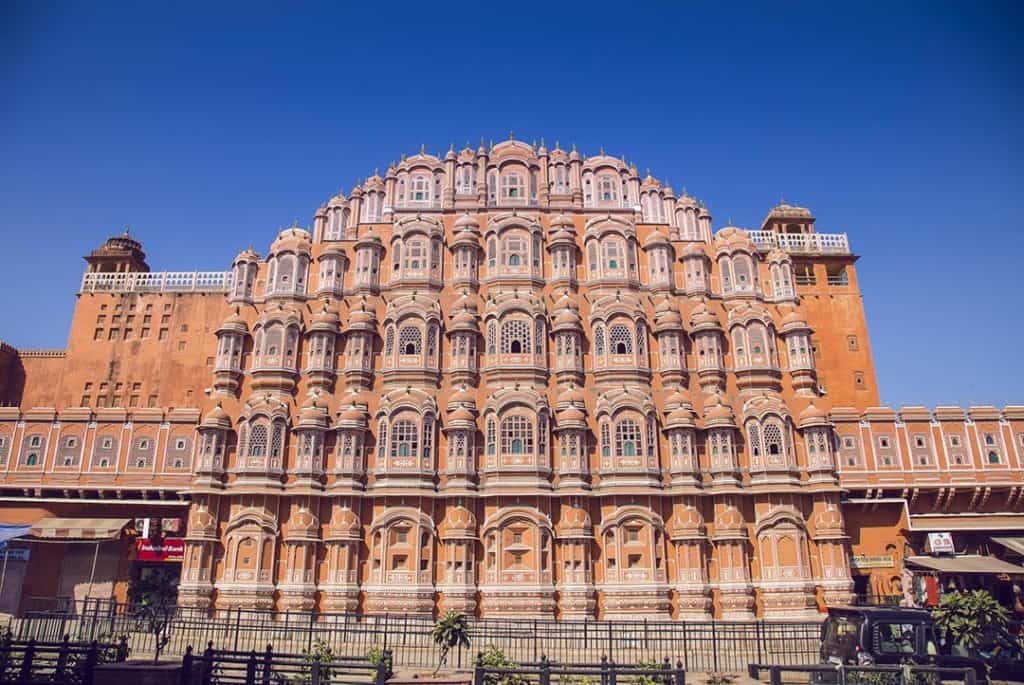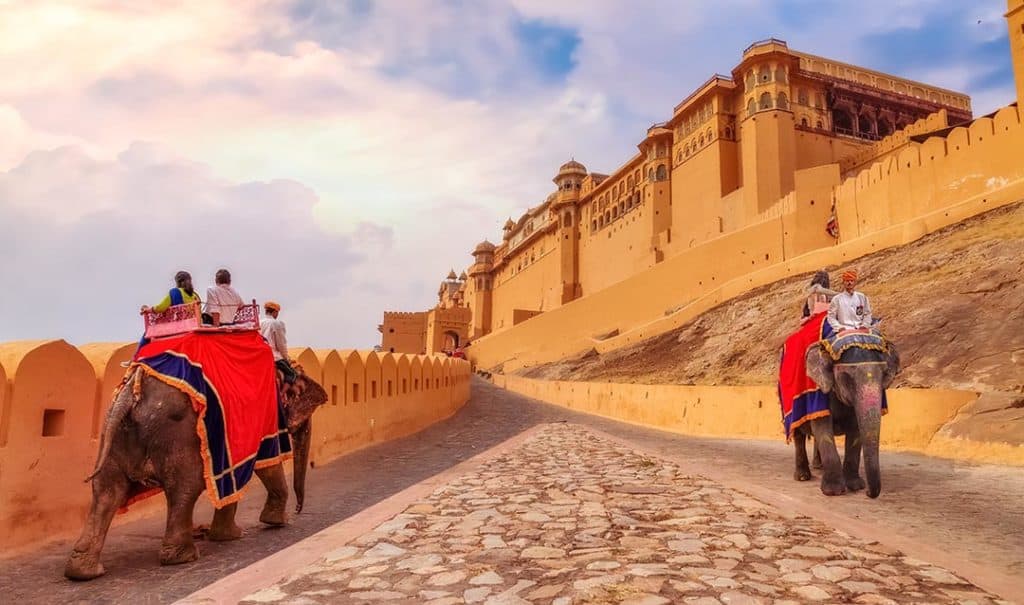Monuments, mausoleums, minarets, mosques—India has them all
How was India? There’s no easy answer. Fascinating. Exhausting. Disturbing. The spectacular sights are spectacular, especially the Taj Mahal, but so is the squalor. India packs a sensory punch of colors, sounds, and smells. Haunting prayer calls, a cacophony of horns. And the traffic! Imagine the Long Island Expressway on a summer Friday with the addition of tuk-tuks, motor scooters, maybe a cow and the occasional elephant.

As first time travelers to India, we elected to stick to the manageable touristic Golden Triangle — Delhi, Agra, and Jaipur. I knew I was no match to figure out India, so we engaged travel consultant Swati Mathur, of Travel and Special Things, to plan an itinerary. We stayed in reasonably-priced Trident hotels, Oberoi’s five-star brand. But as press, I managed to join a guests’ tour of the fabled Taj Rambagh Palace, the first palace to be converted to a luxury hotel and the former home of the legendary beauty the Maharani of Jaipur. Stunning interiors and elaborate Mughal gardens where peacocks strut enchant guests with deep pockets. We had a similar tour at the luxurious Jai Mahal Palace where an elaborate wedding was in progress.
We flew Air India, which puts you into the ambience of the country right away. Just a heads up: in India, security lines are sex segregated and the “ladies” are patted down in a curtained enclosure.
Best of all, our package came with a driver, a luxury I only dreamed of attaining if I won the lottery, but an absolute necessity on India’s chaotic roads.
The capital city is the jumping off point. And it’s worth seeing, pollution and all. New Delhi is the modern capital and is reminiscent of European capitals with wide boulevards and stately government buildings. Old Delhi is a crowded, chaotic jumble of narrow streets, open front shops and markets frequently visited by rickshaw. Agra’s major draw is the Taj Mahal. Jaipur, known as the pink city, is perhaps the most beautiful.
Architectural Marvels
Touring this area largely focuses on the splendid monuments and forts built by the Mughal empire which held sway from the 16th through the 18th centuries. The star of the show is the Taj Mahal in Agra. If you have a bucket list, this is probably on it. It was built by emperor Shah Jahan as a memorial to his favorite wife Queen Mumtaz Mahal, who died giving birth to their 14th child. One of the Seven Wonders of the World, the Indo-Islamic jewel was built by 20,000 workers with the help of 1,000 elephants over the course of 20 some years. Artisans were recruited from throughout the empire to execute calligraphy, intricate carvings, and semi-precious-stone inlaid marble. The white marble façade is particularly captivating at sunrise when it’s gradually illuminated. It’s worth dragging your sleepy ass out of bed for this once-in-a-lifetime view. It can also take on a pinkish hue at sunset and is best viewed from the opposite side across the Yamuna River in the Moonlight Garden.

Magnificent walled cities recall the history of the once powerful Mughals — which frankly I don’t remember ever studying in our Western-centric history classes. We walked miles through these cities, called forts by the British. Ramparts, gates, courtyards, conjure images of royal pomp and ceremony and palace intrigues. Of course, I would have been relegated to watch with all the other women from behind latticed screens. Would I have been a favored queen? Or one of dozens of courtesans serving the emperor at his pleasure?
Each city boasts these remnants of the empire and all are worth seeing but If I had to pick only one, it would be the Amber Fort in Jaipur which is the second most visited site in India after the Taj Mahal. The majestic red sandstone and marble palace sitting atop the hills was occupied by the Rajput Maharajahs and their families. Some tourists take elephant rides up to the fort, a practice that has come under criticism by animal rights activists. I’m skittish around dogs so ride an elephant? Are you kidding? Fortunately, Amber Fort is also reachable by car.
We also walked (shoes off, heads covered) through miles of mosques and temples marveling at their astonishing size and opulence. Delhi’s Jama Masjid built by Shah Jahan, can accommodate 25,000 faithful in its courtyard. The Sikh Temple, Gurudwara Bangla Sahib in Delhi operates what could easily be the world’s largest soup kitchen. Daily, teeming masses, regardless of race or religion, are fed a hearty meal of lentils, rice, and chapatis in the massive dining hall seating approximately 500 at a pop. It’s awe inspiring, though not especially appetizing, to confront vats of lentils in woks the size of a small car and watch rows of volunteers seated cross legged on the floor rolling out chapatis.
Shopping
Don’t be embarrassed to shop. I went on a scarf buying spree. My favorites are the block print scarves at Anokhi a poster child for reviving traditional artisanal textile skills. The company was started nearly 50 years ago by Faith and John Singh. She is the daughter of British missionaries. Her late husband John was a Rajput royal. They met romantically at the Rambagh pool. In addition to its retail stores, Anokhi maintains a tiny, charming museum in a restored mansion in Jaipur, about a ten-minute walk from the Amber Fort. On display are block printed textiles and the tools used to create them.
Recycling saris into scarves is also a thriving cottage industry and these beautiful pieces can be found in numerous shops.
It’s interesting to watch artisans at work weaving carpets or inlaying marble but be warned that visitors are eagerly courted as potential customers. I came within inches of ordering an Indian carpet. “If you buy a big rug, you will get a big house,” the persuasive salesman promised.

Dining
A not-to-be-missed dining experience in Delhi is Indian Accent on the list of the World’s 50 best restaurants. Chef Manish Mehrotra is on a one-man mission to elevate Indian cuisine and is now spreading his gospel at outposts in Manhattan and London. For traditional North Indian cuisine in Delhi, visitors head to Pandara Road and spots like Restaurant Gulati, a popular eatery that started as a kiosk.
There are countless dining options both in the hotels and independent restaurants. It’s not advisable to eat street food. Drink only bottled water. Avoid ice — even in your gin and tonic.
One of the most surprising culinary experiences were the extravagant hotel breakfast buffets which offer an endless selection of both international and Indian dishes. “We do try to give a representative breakfast of products from all around the country but the options are vast and varied and our small buffet would definitely not do the possibilities any justice,” says Trident Jaipur executive chef Zubin D’Souza modestly. But his menu spread sheets belie his modesty. The rotating selections are an almost encyclopedic array of Indian specialties, chutneys, and breads.
Our short trip only scratched the surface both geographically and gastronomically. It would take a lifetime to begin to understand India. But even a small glimpse is enlightening. Overall, it’s humbling to see that what we take for granted is not so easily available outside the first world.
Note: I traveled to India shortly before the pandemic and then the world shut down. So the story was on hold for a couple years. Fortunately, travel is now open again and we can once again look forward to seeing the world.
Beverly Stephen is a freelance travel, food, and lifestyle writer and co-owner of the culinary travel company Flavor Forays.








![Situated on Atlantic Avenue and just two blocks from the beach, The Seagate in DelRay opened its doors in 2009, and like the area around it, the luxury hotel has recently debuted some impressive changes. Inside the hotel, all 157 guest rooms and suites have been renovated from top to bottom while amenities include upscale dining, a beach club, golf course, pickleball courts, spa, pool, and private beach access. [link in bio]](https://hamptonsrealestateshowcase.com/wp-content/uploads/sb-instagram-feed-images/488990822_18503394892030135_7274019688908843053_nfull.webp)
![Just completed and crafted to perfection, 5 Widow Coopers Path boasts 9,692± sq. ft. of luxury living with high-end finish, linear lighting, custom cabinetry, and a keen attention to detail throughout. This sleek open floor plan boasts a sun-filled reception and open floor plan that seamlessly flows through the gallery into the living space. Represented by @jameskpeyton of @thecorcorangroup. [link in bio]](https://hamptonsrealestateshowcase.com/wp-content/uploads/sb-instagram-feed-images/490370207_18503184790030135_3640167241276553057_nfull.webp)
![47 Wireless Way offers a truly exceptional living experience where every detail signifies the ultimate in custom sophistication. This exquisite compound was designed by renowned Architects, Bruce Nagel/Chris Scorgie, with interior and exterior lighting by Caitlin Faron and grounds by Dario’s Landscaping designed to flow seamlessly with this stunning modern home. Represented by @elyn.on.earth and @cristinamatos1025 of @brownharrisstevens. [link in bio]](https://hamptonsrealestateshowcase.com/wp-content/uploads/sb-instagram-feed-images/488798243_18503008249030135_8147552011575678713_nfull.webp)
![A triumph of modern farmhouse design, this newly completed estate sprawls across 1.5± acres, offering breathtaking southern views over a 50± acre reserve. Encompassing over 12,600± sq. ft. across three levels of finely articulated space, 394 Seven Ponds Towd Road is an architectural marvel, designed with luxury, comfort, and functionality in mind. Represented by @depersiahamptons of @thecorcorangroup. [link in bio]](https://hamptonsrealestateshowcase.com/wp-content/uploads/sb-instagram-feed-images/488989044_18502826965030135_3592141958196999080_nfull.webp)
![A sprawling Hamptons oceanfront property, which hit the market last summer, has been sold for a total of $70M, marking the biggest sale so far in 2025! Frank E. Newbold of @sothebysrealty listed 372 and 370 Further Lane in June of 2024. Paul Brennan and Martha Gundersen at @douglaselliman brought the buyer to this deal. [link in bio]](https://hamptonsrealestateshowcase.com/wp-content/uploads/sb-instagram-feed-images/488218792_18502361422030135_5131302832788622101_nfull.webp)
![In the fine art world, you will be delighted to discover @brendanhjohnston, a young artist with an old master approach. While many credit “talent,” Johnston emphasizes the importance of training. The renaissance approach is to master drawing, painting and sculpture from real life. [link in bio]](https://hamptonsrealestateshowcase.com/wp-content/uploads/sb-instagram-feed-images/488712809_18502145848030135_7241807570408860772_nfull.webp)
![Experience the best of both worlds with exclusive beachfront and boating access in this exceptional Southampton property. Set in a sought-after waterfront community, 21 East Shore Drive offers an impressive 111± ft. of private sandy beach and protected bulkhead, with water on both sides. Represented by @angelaboyerstump of @sothebysrealty. [link in bio]](https://hamptonsrealestateshowcase.com/wp-content/uploads/sb-instagram-feed-images/488569507_18501957808030135_1349506531287636033_nfull.webp)
![First time ever on the market, this is a unique opportunity to own in the desirable and charming Historic District in the Village of Sag Harbor. 63 Glover Street is considered the most sought-after in the Village, boasting 100± ft. of panoramic water frontage, half bulkheaded, on Sag Harbor Cove with a deep water dock and a separate living cottage. Represented by @thebestofthehamptons of @brownharrisstevens. [link in bio]](https://hamptonsrealestateshowcase.com/wp-content/uploads/sb-instagram-feed-images/488065237_18501743197030135_1061235731645102537_nfull.webp)
